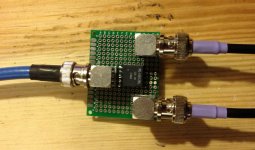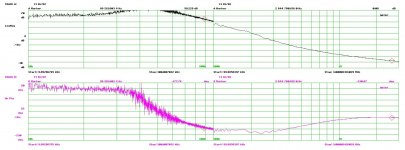Well I always understood it as the situation where the Ic cannot be increased by increasing Ib. Like the literal meaning of the word 'saturation'?
Vbe and Vce at saturation is not very well defined and varies between device types, so it would be a poor definition.
But I'll look it up.
Edit:
'As the forward bias in a semiconductor P-N junction increases, the current through the junction also increases, up to a certain point. When the bias is increased beyond that point (called the saturation point), no further increase in the current occurs. A bipolar transistor becomes saturated when the base-emitter current reaches a maximum under conditions of changing bias. In the characteristic curve (current versus forward bias) of an amplifying or switching device, saturation is indicated by a leveling off of the curve as the forward bias increases.'
This is almost how I understood it - I thought it was the Ic that no longer can increase with Ib, but it appears the correct definition is when Ib can no longer increase with increased base voltage. Which of course also implies Ic is saturated.
Jan
Vbe and Vce at saturation is not very well defined and varies between device types, so it would be a poor definition.
But I'll look it up.
Edit:
'As the forward bias in a semiconductor P-N junction increases, the current through the junction also increases, up to a certain point. When the bias is increased beyond that point (called the saturation point), no further increase in the current occurs. A bipolar transistor becomes saturated when the base-emitter current reaches a maximum under conditions of changing bias. In the characteristic curve (current versus forward bias) of an amplifying or switching device, saturation is indicated by a leveling off of the curve as the forward bias increases.'
This is almost how I understood it - I thought it was the Ic that no longer can increase with Ib, but it appears the correct definition is when Ib can no longer increase with increased base voltage. Which of course also implies Ic is saturated.
Jan
Last edited:
Building a probe to measure directly the loop gain is very easy, but of course it then requires a log sweep generator from KHz up to 5-10MHz.
P.S. In case you are wondering how to build a decent loop gain probe: http://lib.ugent.be/fulltxt/RUG01/002/033/143/RUG01-002033143_2013_0001_AC.pdf ch. 5.1.3 and the following. Attached is a picture of such a loop gain probe, and the results of measuring a wideband 2 pole compensated opamp (it's not a commercial type, but a building block in a mixed signal IC design library).
Attachments
Last edited:
is "saturation" defined as:
Vce = 0
or
Vce << Vbe
But I'll look it up.
Please do:
http://www-inst.eecs.berkeley.edu/~ee105/sp08/lectures/lecture5_6.pdf
http://www.utdallas.edu/~torlak/courses/ee3311/lectures/lecture4.pdf p.39
http://www.dauniv.ac.in/downloads/Electronic Devices/04EDCBipolarJunctionsTransistorLesson04.pdf
Etc... Google is your friend.
I have no need to argue with you, Waly. You might doubt anything. However, the method works for me, with the topologies I measure. Open loop gain is 80 dB. I agree that 100 dB would make a problem.
I have no need to argue with you, Waly. You might doubt anything. However, the method works for me, with the topologies I measure.
No need to argue, just show some relevant and credible results.
Thanks for those 3 links.
The first and last confirm that saturation is defined as Vce < Vbe, i.e. CB is reversed
Unfortunately link 2 does not have 39pages.
This confirms my assumption that Vce simply needs to be low for the transistor to be in saturation mode.
Vce does not need to be zero !
from post20
The first and last confirm that saturation is defined as Vce < Vbe, i.e. CB is reversed
Unfortunately link 2 does not have 39pages.
This confirms my assumption that Vce simply needs to be low for the transistor to be in saturation mode.
Vce does not need to be zero !
from post20
saturation is at Vce=0.
Last edited:
Thanks for those 3 links.
The first and last confirm that saturation is defined as Vce < Vbe, i.e. CB is reversed
Unfortunately link 2 does not have 39pages.
This confirms my assumption that Vce simply needs to be low for the transistor to be in saturation mode.
Vce does not need to be zero !
from post20
"CB is reversed" is wrong. For a NPN, with the usual sign convention, Vbe-Vce+Vcb=0, it's called Kirchoff. "Vce is low" is not a definition, it's a hunch. Of course Vce=0 when Vbe is exactly equal to Vcb, which never happens in a real circuit.
Slide 39, not page 39.
Thanks for those 3 links.
The first and last confirm that saturation is defined as Vce < Vbe, i.e. CB is reversed
Unfortunately link 2 does not have 39pages.
This confirms my assumption that Vce simply needs to be low for the transistor to be in saturation mode.
Vce does not need to be zero !
from post20
Be carefull not to read 'Vce is low/zero at saturation' as 'saturation is defined as Vce low/zero' - Waly makes the same error.
Jan
'saturation is defined as Vce low/zero'
That definition is correct, no errors. Your definition that involves currents is wrong (or at least not widely accepted). Please review the references.
This is what I think. Transistor is controlled by Vbe (not the base current - the base current is a "secondary effect" here). Same thing with collector. Ic cannot increase any more because Vce went below Vbe. But "V" is primary here, "I" is secondary.
So, definition with "V" is more correct.
Cheers,
Valery
So, definition with "V" is more correct.
Cheers,
Valery
............ saturation is defined as Vce < Vbe, i.e. CB is reversed..........
CB is normally biased such that the voltage on C exceeds the voltage on B. i.e. Vce> Vbe."CB is reversed" is wrong.............
When the voltage on C is lower than the voltage on B the CB junction is reversed from the norm. i.e Vce < Vbe.
What wrong with
?Vce < Vbe, i.e. CB is reversed
And it so happens that when CB sees a reversed voltage that the transistor enters the saturation zone/mode.
..............defined as Vce < Vbe,.............Vce simply needs to be low .................
.............. "Vce is low" is not a definition, ............
............. 'saturation is defined as Vce low/zero' .................
Jan
I say it and you reply that Vce is Low is not a definition.That definition is correct, ............
Jan says it and you agree it is the definition.
Surely Vce < Vbe is clear?
And having just stated that, to add immediately afterwards that Vce is low
links the two statements and thus implies the full correlation.
I say it and you reply that Vce is Low is not a definition.
Jan says it and you agree it is the definition.
Surely Vce < Vbe is clear?
And having just stated that, to add immediately afterwards that Vce is low
links the two statements and thus implies the full correlation.
You don't get it, I can't spend more time on this. Do your homework, understand how the bipolar transistor is working and align your terminology. E.g. "reversed" is always used in the context of "reverse biased".
Thanks for those 3 links.
The first and last confirm that saturation is defined as Vce < Vbe, i.e. CB is reversed
Unfortunately link 2 does not have 39pages............
Slide 39 shows............Slide 39, not page 39.
All three links agree.When collector voltage drops below base voltage and
forward biases the collector-base junction, base current
increases and decreases the current gain factor, b.
Vce=0 is not a necessary condition for defining saturation.
That definition is correct, no errors. Your definition that involves currents is wrong (or at least not widely accepted). Please review the references.
I posted the definition verbatim.
You just posted some links to a bunch of presentation slides that illustrates the results of saturation.
Jan
the 4 transistor "Wilson" current mirror deliberately operates one Q at 0 Vcb - has plenty of gain
forward biasing the cb junction gets you additional diode current that has to come from the base but even 100 mV forward bias is still showing OK hfe with many Q
forward biasing the cb junction gets you additional diode current that has to come from the base but even 100 mV forward bias is still showing OK hfe with many Q
Last edited:
OK. I accept that.............."reversed" is always used in the context of "reverse biased".
That's not saturation, saturation is at Vce=0.
You seem to have made a mistake here, at the start.
The definitions in your quoted links are essentially (to avoid clumsy pedantry about PNP or NPN polarities) that Vbc becomes forward biased.
This is the formal definition that I learned too, for BJT.
That is not the same as Vce=0, yes?
Best wishes
David
Last edited:
- Status
- Not open for further replies.
- Home
- Amplifiers
- Solid State
- Your opinions are sought on Audio Power Amplifier Design: 6th Edition. Douglas Self

